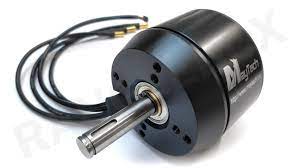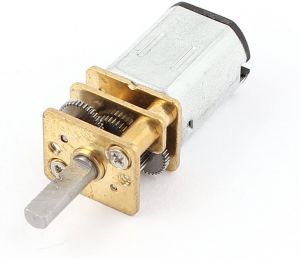Difference between revisions of "Motors"
m (Added Image) |
|||
| Line 11: | Line 11: | ||
==Common brushed DC motors== | ==Common brushed DC motors== | ||
| + | [[File:N20.jpg|thumb|N20 Motor]] | ||
There are literally hundreds of motors to choose from but certain choices have become favorites over the years due to their availability and suitability for robot combat in terms of output-speed at typical voltages, ease of mounting into designs, and robustness. As with all things in robot combat, there are different choices common to different weight classes.<br> | There are literally hundreds of motors to choose from but certain choices have become favorites over the years due to their availability and suitability for robot combat in terms of output-speed at typical voltages, ease of mounting into designs, and robustness. As with all things in robot combat, there are different choices common to different weight classes.<br> | ||
In 150g to 1-pound classes the most common motors are N20 and 16mm motors from places like [https://www.fingertechrobotics.com/products.php?cat=Motors+%26+Mounts FingerTech] or [https://www.botkits.com/collections/all-products BotKits]<br> | In 150g to 1-pound classes the most common motors are N20 and 16mm motors from places like [https://www.fingertechrobotics.com/products.php?cat=Motors+%26+Mounts FingerTech] or [https://www.botkits.com/collections/all-products BotKits]<br> | ||
Revision as of 20:37, 8 June 2021
Electric motors impart a continuous spinning motion and are used in nearly every combat robot. They work by creating a rotating magnetic field, which is used to spin a shaft or a shell at high speed. Many motors will be attached to a gearbox, generally used to decrease the shaft speed and increase torque.
Brushed (DC) Motors
DC Brushed motors have historically dominated the sport due to their availability and simplicity. These motors have an electrical connection to the spinning part of the motor using contacts called brushes.
DC motors have two wires or connections. Apply a suitable DC voltage to these and the motor will spin; reverse the connections, and the motor will spin in the opposite direction.
While these motors can be operated at full speed by switching power on and off as described, an electronic speed controller (ESC) will allow you to control speed by turning the power on and off in very fast pulses. Most ESCs can also reverse the motor direction while in use, so that weapons, tires, etc. can move both ways. Only ESCs made for brushed motors can be used.
Common brushed DC motors
There are literally hundreds of motors to choose from but certain choices have become favorites over the years due to their availability and suitability for robot combat in terms of output-speed at typical voltages, ease of mounting into designs, and robustness. As with all things in robot combat, there are different choices common to different weight classes.
In 150g to 1-pound classes the most common motors are N20 and 16mm motors from places like FingerTech or BotKits
In the 3-pound classes, 25mm spur gear motors and 22mm planetary gear motors are very common.
| Motor Type | Source 1 | Source 2 | Source 3 |
|---|---|---|---|
| N20 Spur Gear | EndBots | ServoCity | DFRobot |
| 16mm Spur Gear | FingerTech | BotKits | |
| 20mm Spur Gear | EndBots | ServoCity | |
| 22mm Planetary Gear | BotKits | RectifiedRobotics | ServoCity |
| 25mm Spur Gear | KitBots | EndBots | ServoCity |
| 25mm Double Spur Gear | AbsoluteChaosRobotics |
Brushless Motors
In recent years DC Brushless motors have become more popular. Brushless motors are often both faster and lighter than an equivalent brushed motor, while experiencing less friction, remaining more efficient and less susceptible to heat related failures.
Brushless motors have 3 or even 4 wires, and they will not operate at all without a brushless electronic speed controller (ESC). This specialized circuit synthesizes the rotating magnetic field by sending waves of power into pairs of wires in sequence. By altering which wires are used, the ESC can also reverse the motor; by adjusting the shape of the waves, it can change the speed and torque of the motor. This gives a builder many options, but can make setup of brushless motors very complicated.
Brushless motors are also known as BLDC (Brushless direct current). There are (at least) two types - sensorless and sensored. The sensorless motors are generally used on flying drones and lower weight class robots as they are simpler and require less wiring. An ESC needs to support the right type of motor, as well as suitable current and voltage rating.
One disadvantage of sensorless brushless motors is that they have very little startup torque so they can't get going quickly, or push at low speeds (if used for drive). This can potentially be fixed by using a sensored motor and/or a very clever ESC.
As brushless drone motors are usually intended to handle only very light startup torque (propellers), they often have difficulty starting when a heavier spinning weapon is attached. You will see many fights lost when a spinner couldn't start up their weapon.
Common brushless DC motors
| Source | Link |
|---|---|
| RectifiedRobotics | Brushless Planetary |
| OwOBotics | OPBox MkIV |
| RobotMatter | Mercury Box |
Picking the right motor
There are tradeoffs between the two motor types so do a little research to determine which is most suitable for you.
Choosing a motor - Brushed or Brushless

